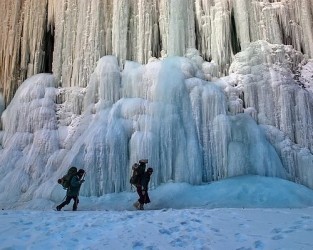Leh
Winter in Ladakh: What Remains Closed During the Cold Months
By - Tribazz
19 September, 2023

.jpg)
Ladakh, a land of rugged beauty and stark landscapes, undergoes a dramatic transformation during the winter months. While this high-altitude region in northern India is a popular destination for adventurers and travelers during the summer, its harsh winter conditions lead to significant changes in accessibility and activities. In this article, we'll explore what remains closed in Ladakh during the winter season, shedding light on the unique challenges and charms of visiting this remote Himalayan destination when the temperatures plummet.
1. Road Access
One of the most noticeable closures in Ladakh during winter is the inaccessibility of many roads due to heavy snowfall. Ladakh's lifeline, the Leh-Manali Highway and other high-altitude passes like Rohtang Pass and Zoji La Pass, become impassable due to snow and ice. The Srinagar-Leh Highway also shuts down. As a result, road travel to and from Ladakh becomes challenging, if not impossible, during the coldest months.
2. Tourist Attractions
Several popular tourist attractions in Ladakh either remain closed or are difficult to access in winter. These include:
Pangong Lake: Frozen over during the winter, Pangong Lake is not the crystal-clear azure expanse that visitors encounter in the warmer months. It becomes a vast, icy landscape and is often inaccessible due to the treacherous road conditions.
Nubra Valley: The high-altitude desert of Nubra Valley sees frigid temperatures in winter, and the roads leading to it are often closed. Camel rides in the sand dunes are also unavailable.
Tso Moriri Lake: Like Pangong Lake, Tso Moriri freezes over in winter, and the surrounding areas become snowbound and challenging to reach.
3. Accommodations and Services
Many guesthouses, hotels, and restaurants in Ladakh shut down during the winter due to the reduced influx of tourists. The region's remote locations make it costly to maintain these establishments during the winter months when business is slow. Travelers should check in advance to ensure they have access to accommodations and dining options.
4. Limited Activities
Adventure activities like trekking, mountain biking, and river rafting are not feasible in Ladakh during the winter due to the freezing temperatures and challenging terrain. This is a time when the region is more suitable for those seeking solitude, tranquility, and a unique winter experience rather than adrenaline-pumping adventures.
5. Monastery Visits
While many monasteries in Ladakh are open year-round, the winter months can make visiting them more challenging. Some monasteries may have reduced visiting hours or be less accessible due to snow-covered roads.
6. Medical Facilities
It's essential to be aware that medical facilities in remote areas of Ladakh may be limited or less accessible during the winter. Travelers with specific medical needs should plan accordingly and carry necessary medications and supplies.
7. Chadar Trek
On a positive note, one unique winter activity that draws adventurers to Ladakh is the Chadar Trek. This trek involves walking on the frozen Zanskar River and offers an unparalleled opportunity to experience the region's winter beauty. However, it's essential to undertake this challenging trek with an experienced guide and proper gear.
While Ladakh offers a remarkable and serene winter experience, it's essential for travelers to be aware of the closures and limitations that come with the season. The region's extreme cold and heavy snowfall make it a destination for those seeking a different kind of adventure—one that embraces the stark beauty and tranquility of the Himalayan winter. Planning ahead and being prepared for the unique challenges of winter travel in Ladakh will ensure a memorable and safe experience.